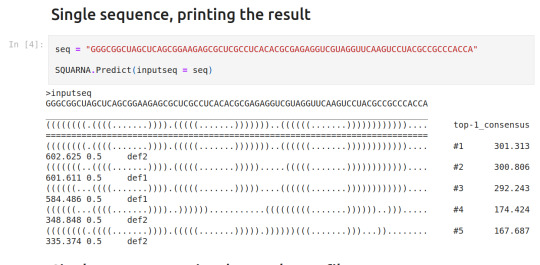I develop innovative algorithms and best-in-class tools for RNA computational structural biology: https://imol.institute/leaders/baulin-group/
Don't wanna be here? Send us removal request.
Text

The coordination loop in group II introns forms a chimeric kink-turn that involves a long-range base pair (A251-U326).
More weird kink-turns in our recent preprint: https://doi.org/10.1101/2024.05.31.596898
#RNA #ARTEM #Kinkturn #Kturn #Motif #Bioinformatics #Science #Research #StructuralBiology
1 note
·
View note
Text

Our ARTEMIS tool for aligning 3D structures of nucleic acids is now equipped with a detailed Tutorial, covering structure searches, sub-optimal matches, and even PDB/CIF conversion, check it out: https://github.com/david-bogdan-r/ARTEMIS/blob/main/ARTEMIS_TUTORIAL_v1.51.pdf
#rna#3d#dna#structure#alignment#superposition#bioinformatics#structuralbiology#science#research#pdb#tutorial
0 notes
Text

Happy to share, DesiRNA is now published at Nucleic Acids Research! https://doi.org/10.1093/nar/gkae1306 DesiRNA is a tool for RNA sequence design (inverse folding) and it is the first to solve all 100 puzzles in the Eterna100 benchmark within 24 h!
1 note
·
View note
Text

Our ARTEM tool for RNA 3D motif search does not rely on annotated pairwise interactions. Thus, it could identify a D-loop/T-loop-like motif with two non-interacting pyrimidines (U206/U233, right) instead of the characteristic long-range base pair (left).
Find out more: https://doi.org/10.1093/nar/gkad605
0 notes
Text

These recurrent RNA "staple" interactions were reported in our recent paper in Nucleic Acids Research. They are inherently non-planar and not decomposable into base pairs and, therefore remain invisible to existing annotation tools.
Find out more:
https://doi.org/10.1093/nar/gkad605
1 note
·
View note
Text

In the raiA ncRNA structure that we recently determined, we identified a junction strand (B) that mimics both the GAAA-tetraloop (A) AND the D-loop/T-loop interaction motif (C) - how cool is that?
Find out more: https://doi.org/10.1016/j.jmb.2024.168833
#rna#research#science#structure#structuralbiology#cryoEM#junction#tetraloop#strand#motif#Dloop#Tloop#GAAA#GNRA#raiA
0 notes
Text

Now it's that simple to predict RNA secondary structure with SQUARNA Python3 library:
pip install SQUARNA
import SQUARNA SQUARNA.Predict(inputseq="CCCGNRAGGG")
Demo: github.com/febos/SQUARNA/blob/main/demo.ipynb
BioRxiv: doi.org/10.1101/2023.08.28.555103
1 note
·
View note
Text

These are two RNA 3D structure modules: one is a long-range helix-helix interface and another is a four-way junction loop, but can you spot the difference?🧐 Find out which is which in our recent preprint on RNA tertiary motif search and their isostericity: https://doi.org/10.1101/2024.05.31.596898
#rna#dna#3d#science#structure#structuralbiology#bioinformatics#research#isostericity#motif#artem#junction#helix#module
0 notes
Text
Happy to share, ARTEMIS is now published at NAR!
https://doi.org/10.1093/nar/gkae758
ARTEMIS is a new tool for RNA/DNA 3D structure superposition and structure-based sequence alignment. Our benchmarks show that it outperforms the existing tools for both sequentially-ordered and topology-independent alignment.
ARTEMIS allowed us to identify an intriguing structural similarity between Lysine and M-box riboswitches (see the figure) and to describe the minor-groove/minor-groove helical packing motif. ARTEMIS is the first tool able to report several alternative superpositions, which makes it suitable for structural motif identification tasks.
ARTEMIS is available at GitHub: https://github.com/david-bogdan-r/ARTEMIS
Thanks to Davyd Bohdan, Janusz Bujnicki, & International Institute of Molecular and Cell Biology in Warsaw!

#rna#dna#3d#science#bioinformatics#structuralbiology#research#innovation#structure#topology#sequence#superposition#alignment
8 notes
·
View notes
Text
ARTEM: THE tool for RNA 3D motif identification, with backbone permutations!

ARTEM identifies RNA tertiary motifs based purely on their isostericity. We applied it to search for kink-turn-like motifs and discovered two new kink-turn topologies, multiple no-kink variants of the motif, and showed that a ribosomal junction in bacteria forms either a kink or a no-kink variant depending on the species (see the Figure). We also identified kink-turns in the catalytic core of group II introns, whose structures have not previously been characterized as containing kink-turns.
ARTEM opens a fundamentally new way to study RNA 3D folds and motifs and analyze their correlations and variations.
Want to learn more? - Check out our preprint on bioRxiv doi.org/10.1101/2024.05.31.596898 - ARTEM is available for you on GitHub https://github.com/david-bogdan-r/ARTEM https://github.com/febos/ARTEM-KT
#rna#science#bioinformatics#structuralbiology#research#innovation#algorithms#biology#motif#3D#structure#kinkturn#kjunction#ARTEM#permutation#permutations
0 notes
Text
Our works on RNA structure analysis and prediction.
3 notes
·
View notes